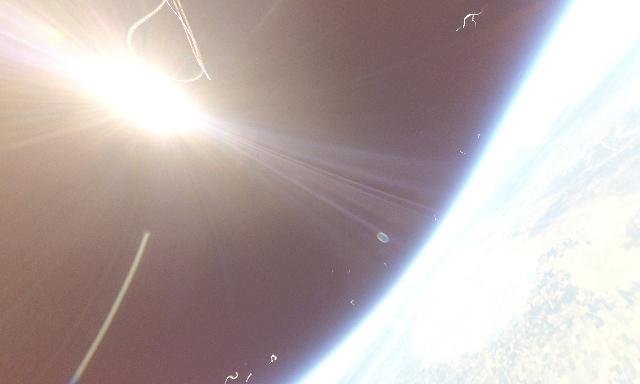Eos II

Immersive term Atmospheric Science and Engineering weather balloon project 2021
As part of The Bay School's immersive program, "atmospheric science and engineering" students take a three-week course in which they refine their understanding of Earth's atmosphere experimentally, building and releasing weather balloon payloads to record data about different characteristics of the atmosphere. The Eos II mission took place on on June 2, 2021.
On June 2nd we launched three weather balloons--named Dawn, Dusk, and Midnight--each equipped with flight computers using Adafruit Feather M0 hardware running Arduino software. We added pressure sensors, an infrared radiation (IR) and humidity sensor, and a temperature sensor. A separate Automatic Packet Reporting System GPS (APRS) transmitter was also attached to send the current location of the weather balloon it was on. Additionally a Spot satellite tracker was added for backup tracking, completing the payload. We launched the balloons from Hensley Lake at 8:13:45 A.M. and each had its own journey.


Midnight burst at 86,581 feet after merely 2 hours and 22 minutes of flight time. After falling for 26 minutes, Midnight was retrieved by both students and teachers around noon. Dawn and Dusk flew higher, reaching final heights of 103,609 feet and 108,087 feet, respectively. Dawn burst 3 hours and 26 minutes after launch then landed at 12:05 P.M. also falling for 26 minutes. Dusk burst 3 hours and 31 minutes after launch then landed 21 minutes later in unison with Dawn at 12:05 P.M. Alumni from the Bay School crossed the San Joaquin river and found one payload on their own and found the second with the help of an orchard manager.
Flight statistics
Midnight |
Dusk |
Dawn |
|
Release time |
8:13 am |
8:13 am |
8:13 am |
Flight Duration |
2 hours 48 minutes |
3 hours 52 minutes |
3 hours 52 minutes |
Ascent Time |
142 minutes |
211 minutes |
206 minutes |
Descent time |
26 minutes |
21 minutes |
26 minutes |
Distance Traveled |
44 km (27.3 mi) |
56.6 km (35.2 mi) |
56.3 km (35 mi) |
Max Ascent Rate |
4.0 m/s (787 ft/min) |
3.4 m/s (669 ft/min) |
3.3 m/s (650 ft/min) |
Max Altitude |
26,290 m (86,581 ft) |
31,580 m (103,609 ft) |
32,945 m (108,087 ft) |
Lowest pressure |
23 hPa |
9.9 hPa |
6 hPa |
Max Descent Rate |
29 m/s (64 mph) |
24 m/s (55 mph) |
29 m/s (61 mph) |
Landing speed |
? |
? |
? |
Eos II Common Occurrences:
- Almost all flight computers shut off during flight due to their batteries getting too cold
- All DHT (Digital Temperature & Humidity sensor) sensors could not measure below -40 ˚C
- Temperature of space (with atmosphere buffer) measured as low as -208.77 ˚C
- Both Dawn’s and Dusk’s carbon fiber rods holding the payloads broke on landing impact
Eos II Outliers:
- One computer recorded the entire flight
- Midnight’s balloon was approximately two years older than Dawn and Dusk (degraded rubber most likely led to a lower altitude as to where Midnight burst)
- Midnight’s rod stayed intact even though it was carrying the 2nd heaviest payload
Difference between Ikaros and Eos missions:
| Ikaros | Eos |
| One weather balloon | Multiple weather balloons |
| One flight computer (heavier/bigger equipment | Multiple flight computers: up to 3 on each balloon |
| Helium lifting gas | Hydrogen lifting gas |
Eos II innovations:
- Custom payload containers made from laminated paper
- Mylar used inside to minimize radiative heat loss
Constructing packaging to hold a flight computer
 Balloons rising seconds after release
Balloons rising seconds after release

Dusk looks back on Hensley Lake

Burst!

Dusk's view tumbling back to Earth
Inspecting Midnight at its landing site
Evaluating payload post-flight